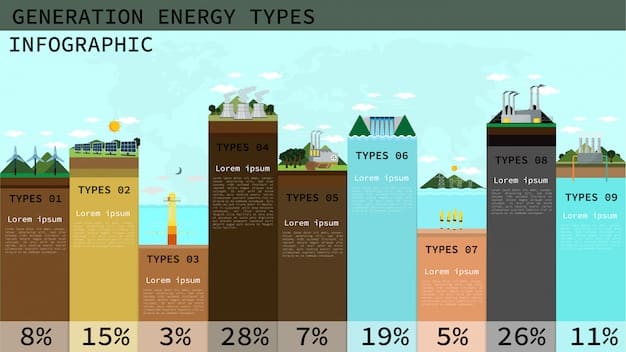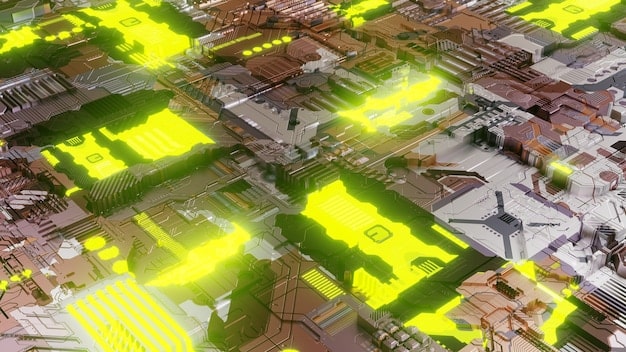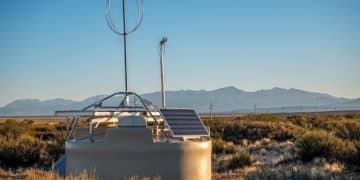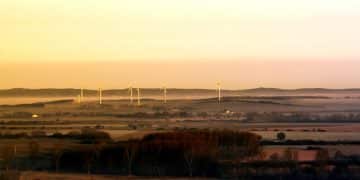Achieving 100% Clean Energy in the US by 2035: How Realistic Is It?

The US aims to achieve 100% clean energy by 2035 through a combination of renewable energy expansion, grid modernization, policy incentives, and technological innovation, focusing on solar, wind, and energy storage solutions to decarbonize the power sector.
The United States has set an ambitious goal: How Will the US Achieve Its Goal of 100% Clean Energy by 2035? It’s a monumental task requiring significant shifts in energy production, policy, and infrastructure, prompting many to wonder if it’s truly attainable.
Understanding the 2035 Clean Energy Target
The goal of achieving 100% clean energy by 2035 represents a significant commitment to addressing climate change and transitioning to a sustainable energy future. This ambitious target necessitates a complete transformation of the US energy sector, moving away from fossil fuels and embracing renewable and other clean energy sources.
The core of this objective lies in decarbonizing the power grid, which currently relies heavily on coal, natural gas, and nuclear power. Transitioning to 100% clean electricity involves integrating various clean energy technologies while ensuring grid stability and reliability.
The Biden Administration’s Commitment
The Biden administration has made the 2035 clean energy target a cornerstone of its climate policy. This commitment is reflected in various executive actions, legislative proposals, and federal investments aimed at accelerating the deployment of clean energy technologies and infrastructure.
These efforts include initiatives to promote renewable energy development, enhance energy efficiency, and support the electrification of transportation and other sectors. The administration’s focus extends beyond just reducing emissions; it also aims to create jobs, boost economic growth, and enhance energy security through the transition to clean energy.
- Policy and Regulations: Implementing supportive policies and regulations at the federal and state levels.
- Investment in Infrastructure: Allocating substantial investments in grid modernization and energy storage.
- Incentives for Renewable Energy: Providing incentives for the development and deployment of renewable energy technologies.
The 2035 clean energy target is not just an environmental goal; it’s an economic and social imperative, promising to reshape the US energy landscape and create a more sustainable and equitable future.
The Current Energy Landscape in the US
To truly understand the challenge of reaching 100% clean energy by 2035, it’s vital to examine the current energy landscape in the US. This involves assessing the existing energy mix, infrastructure limitations, and the progress made in renewable energy deployment.
The US energy sector is a complex mix of fossil fuels, nuclear power, and renewable energy sources. While renewable energy has experienced substantial growth in recent years, fossil fuels still dominate the overall energy supply.

Fossil Fuel Dependence
Coal and natural gas remain the primary sources of electricity generation in the US. These fossil fuels provide a reliable and dispatchable source of power, but they come with significant environmental costs, including greenhouse gas emissions and air pollution.
Despite efforts to reduce coal consumption, it still accounts for a substantial portion of the power grid. Natural gas has become increasingly prevalent due to its lower emissions compared to coal and its role as a bridge fuel in the transition to renewable energy.
Renewable Energy Growth
Renewable energy sources, such as solar, wind, hydro, and geothermal, have experienced significant growth in recent years. The cost of solar and wind energy has declined dramatically, making them increasingly competitive with fossil fuels.
Several states have also set ambitious renewable energy targets, driving further investment and deployment. However, challenges remain in integrating these variable renewable energy sources into the grid and ensuring grid stability.
- Solar Power: Expanding solar energy production through utility-scale solar farms and distributed solar installations.
- Wind Energy: Increasing wind energy capacity through onshore and offshore wind projects.
- Hydroelectric Power: Leveraging existing hydroelectric facilities and exploring potential for new hydropower development.
The shift from fossil fuels to clean energy requires a multifaceted approach, including technological innovation, policy support, and infrastructure upgrades. Understanding the current energy landscape is crucial for charting a path toward a 100% clean energy future.
Key Strategies for Achieving the 2035 Goal
Achieving the ambitious goal of 100% clean energy by 2035 requires a comprehensive strategy that encompasses technological innovation, policy support, and infrastructure development. These strategies must work in tandem to accelerate the deployment of renewable energy while ensuring grid stability and reliability.
The transition to clean energy necessitates significant investments in new technologies, such as advanced energy storage, smart grid infrastructure, and carbon capture and sequestration. These technologies can help mitigate the variability of renewable energy sources and reduce emissions from the power sector.
Expanding Renewable Energy Capacity
One of the primary strategies for achieving the 2035 goal is to dramatically increase renewable energy capacity across the US. This involves deploying utility-scale solar and wind projects, as well as promoting distributed solar installations on residential and commercial buildings.
Expanding renewable energy capacity requires addressing challenges related to land use, permitting, and grid interconnection. Streamlining the permitting process and investing in transmission infrastructure can help accelerate the deployment of renewable energy projects.
Modernizing the Grid
A crucial component of achieving the 2035 clean energy goal is modernizing the nation’s aging grid infrastructure. The existing grid is not designed to handle the influx of variable renewable energy sources, and upgrades are needed to ensure grid stability and reliability.
Grid modernization involves implementing smart grid technologies, such as advanced sensors, communication networks, and control systems, that can monitor and manage the flow of electricity in real-time. It also includes expanding transmission capacity to connect remote renewable energy resources to urban load centers.

- Smart Grid Technologies: Implementing advanced sensors and control systems to monitor and manage electricity flow.
- Transmission Infrastructure: Expanding transmission capacity to connect remote renewable energy resources to urban areas.
- Energy Storage: Deploying energy storage solutions to mitigate the variability of renewable energy sources.
By implementing these key strategies, the US can pave the way for a clean energy future while maintaining a reliable and affordable electricity supply.
The Role of Policy and Regulation
Effective policy and regulation are essential for achieving the 2035 clean energy goal. Governmental policies can incentivize renewable energy development, establish emissions reduction targets, and promote energy efficiency.
Supportive policies at the federal and state levels can create a level playing field for renewable energy technologies and accelerate the transition to a clean energy economy. This includes measures such as tax credits, renewable portfolio standards, and carbon pricing mechanisms.
Federal Policy Initiatives
At the federal level, policy initiatives such as the Inflation Reduction Act provide significant tax credits and incentives for renewable energy development, energy storage, and electric vehicle adoption. These incentives can help drive down the cost of clean energy technologies and make them more competitive with fossil fuels.
Federal regulations, such as the Clean Power Plan, can also play a crucial role in reducing emissions from the power sector. While the Clean Power Plan faced legal challenges, it demonstrated the potential for federal regulations to drive meaningful emissions reductions.
State-Level Actions
Many states have already taken aggressive action to promote clean energy through renewable portfolio standards, which require utilities to obtain a certain percentage of their electricity from renewable sources. These standards have been effective in driving renewable energy deployment and reducing emissions at the state level.
- Renewable Portfolio Standards (RPS): Requiring utilities to obtain a specified percentage of their electricity from renewable sources.
- Tax Credits and Incentives: Providing tax credits and financial incentives for renewable energy development.
- Energy Efficiency Standards: Establishing energy efficiency standards for buildings and appliances.
By harmonizing federal and state policies, the US can create a supportive regulatory environment that accelerates the transition to a clean energy future.
Challenges and Obstacles to Overcome
While the goal of achieving 100% clean energy by 2035 is ambitious and laudable, there are numerous challenges and obstacles that must be addressed. These challenges range from technological limitations to economic considerations and political opposition.
One of the primary challenges is ensuring grid reliability and stability as the share of variable renewable energy sources, such as solar and wind, increases. Energy storage solutions, such as batteries and pumped hydro, can help mitigate this challenge, but further technological advancements and cost reductions are needed.
Technological Limitations
Energy storage remains a significant technological hurdle. Current battery technologies are expensive and have limited storage capacity, making it difficult to rely solely on batteries for grid-scale energy storage. Further research and development are needed to improve the performance and reduce the cost of energy storage technologies.
Another technological challenge is the intermittency of renewable energy sources. Solar and wind energy are dependent on weather conditions, which can fluctuate significantly. Improved forecasting techniques and grid management strategies are needed to address this intermittency.
Economic Considerations
The transition to clean energy requires substantial investments in new infrastructure and technologies. These investments can be costly, and there is a risk that they could lead to higher electricity prices for consumers.
- Grid Reliability: Ensuring grid stability and reliability with a high percentage of variable renewable energy sources.
- Energy Storage Costs: Reducing the cost of energy storage technologies to make them more economically viable.
- Political Opposition: Overcoming political opposition to clean energy policies and regulations.
Overcoming these challenges will require a concerted effort from government, industry, and the research community.
The Economic and Social Impacts
The transition to 100% clean energy by 2035 could have profound economic and social impacts on the United States. While there are potential benefits, such as job creation and reduced healthcare costs, there are also concerns about potential disruptions and challenges.
One of the most significant potential benefits is the creation of new jobs in the clean energy sector. The deployment of renewable energy technologies, the construction of new infrastructure, and the development of advanced energy storage solutions could all create significant employment opportunities.
Job Creation and Economic Growth
The clean energy transition has the potential to drive economic growth by stimulating innovation, attracting investment, and creating new industries. The development and manufacturing of clean energy technologies could become a major source of economic activity in the US.
The transition to clean energy could also reduce healthcare costs by improving air quality and reducing pollution-related illnesses. Fossil fuel combustion is a major source of air pollution, and reducing reliance on fossil fuels could lead to significant public health benefits.
Equity and Environmental Justice
The transition to clean energy must be managed in a way that promotes equity and environmental justice. Historically, marginalized communities have borne a disproportionate burden of pollution and environmental degradation. Clean energy policies should be designed to ensure that these communities benefit from the transition.
- Job Creation: Creating new jobs in the clean energy sector.
- Economic Growth: Stimulating innovation and attracting investment in clean energy technologies.
- Environmental Justice: Ensuring that marginalized communities benefit from the transition to clean energy.
By carefully considering the economic and social impacts of the clean energy transition, the US can maximize the benefits and minimize the disruptions.
| Key Point | Brief Description |
|---|---|
| ☀️ Renewable Expansion | Increasing solar, wind, and hydro capacity for clean energy. |
| ⚡ Grid Modernization | Upgrading grid infrastructure for reliability and efficiency. |
| 💰 Policy Incentives | Using tax credits and regulations to boost clean energy. |
| 🔋 Energy Storage | Developing advanced energy storage technologies. |
Frequently Asked Questions
▼
100% clean energy refers to an energy system that relies entirely on renewable and zero-emission sources like solar, wind, hydro, and nuclear, effectively eliminating fossil fuels.
▼
The US is aiming for 100% clean energy to mitigate climate change, reduce air pollution, enhance energy security, and foster economic growth in sustainable sectors.
▼
The main renewable energy sources include solar, wind, hydroelectric, geothermal, and biomass, each with unique characteristics and roles in the energy transition.
▼
Energy storage is crucial for balancing the variable supply of renewables, ensuring grid stability, and providing reliable power even when renewable sources aren’t actively generating.
▼
Individuals can support clean energy by using energy-efficient appliances, adopting solar panels, driving electric vehicles, and advocating for clean energy policies in their communities.
Conclusion
Achieving 100% clean energy in the US by 2035 is a monumental task, demanding rapid technological advancements, supportive policies, massive investments, and societal commitment. While the challenges are significant, the potential benefits—environmental sustainability, economic growth, and enhanced energy security—make it a goal worth striving for.





